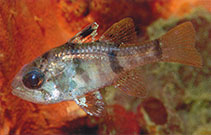| Family: |
Apogonidae (Cardinalfishes), subfamily: Apogoninae |
| Max. size: |
4.1 cm SL (male/unsexed) |
| Environment: |
pelagic-neritic; marine; depth range 20 - 60 m |
| Distribution: |
East Indian to Western Pacific: Western Australia, Indonesia, Brunei and Palau. |
| Diagnosis: |
Dorsal spines (total): 8-8; Dorsal soft rays (total): 9-10; Anal spines: 2-2; Anal soft rays: 8-9. This species is characterized by having a blackish spot on the first-dorsal fin; 5 brownish bars on body and caudal peduncle; broad faint cheek mark; high postocular darkish spot; 14 pectoral-fin rays with a tiny to small darkish spot above the axil (Ref. 83499). |
| Biology: |
This species is usually found solitary or in pairs at about 10-40 meters. It also displays a cryptic behavior, at least during daylight hours, sheltering between rocks and rubble. It has not been observed free swimming, but only when flushed from its lair with the use of clove-oil or rotenone. Specimens collected were living in a rubble field in sheltered waters at the base of a small islet or were found under rock slabs on a submerged patch reef (several km from shore) with abundant sponges and gorgonians and minimal hard corals. Some specimens were also collected from a flat sand and shell bottom with abundant Gonipora, some Fungia and considerable macroalgae (Ref. 83499). |
| IUCN Red List Status: |
Least Concern (LC); Date assessed: 14 August 2023 Ref. (130435)
|
| Threat to humans: |
harmless |
Source and more info: www.fishbase.org. For personal, classroom, and other internal use only. Not for publication.
